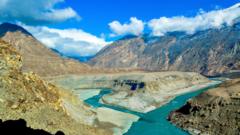The suspension of the 1960 Indus Waters Treaty by India raises questions about whether the nation can effectively stop water flowing into Pakistan. As experts weigh in on the feasibility and impact of this action, the region's historical tensions over water management become increasingly pressing.
India and the Indus Waters: Can Water Flow Be Controlled?

India and the Indus Waters: Can Water Flow Be Controlled?
An exploration of India’s recent suspension of the Indus Waters Treaty amidst escalating tensions with Pakistan and the implications for water management in the region.
Following a significant increase in tensions after an attack in Indian-administered Kashmir, India has temporarily suspended the 1960 Indus Waters Treaty (IWT), which has governed the water rights of six rivers between India and Pakistan. This treaty has historically stood strong despite two wars, serving as a vital framework for water resource management for both nations. However, the recent suspension raises the question of whether India can effectively control the flow of the Indus River and its tributaries into Pakistan, amidst allegations from India of Pakistani support for cross-border terrorism—claims that Pakistan has publicly denied.
The IWT allocates river rights, granting India control over three eastern rivers while allowing Pakistan dominance over the western rivers. Given the reliance of Pakistan—where over 80% of agriculture and significant hydropower depend on these waters—any alteration to water sharing could have severe repercussions. India is making the case for reviewing the treaty due to shifting needs in the face of climate change, but both countries have previously turned to legal channels when disputes arose under the IWT framework.
Experts caution that, while India may contemplate water diversion strategies, building significant infrastructure to control the Indus basin's waters poses considerable challenges. India often relies on run-of-the-river hydropower plants that generate energy without large-scale water storage, limiting the nation’s ability to manipulate water flow comprehensively. Although the treaty allows for adjustments, experts argue that the infrastructure currently in place does not support large-scale water diversion without Pakistan’s awareness.
Nevertheless, some analysts speculate that India could potentially alter existing infrastructure to manage water resource usage without notifying Pakistan, an action that could noticeably affect Pakistan during peak drought seasons when water scarcity is most acute. Additionally, sharing hydrological data, essential for flood management and agriculture, might also be curtailed, which could worsen the situation during monsoon floods.
The complexities intensify when considering possible "weaponization" of water, an idea that refers to using upstream water control as a strategic advantage against downstream nations. While such drastic measures could present risks to India itself, the implications for Pakistan could be devastating. The potential ability of India to manage water flows raises not only concerns over immediate regional security but also draws attention to broader geopolitical issues, including China’s increasing influence over water resources in the Brahmaputra basin, which further complicates the regional dynamics surrounding trans-boundary water management.



















